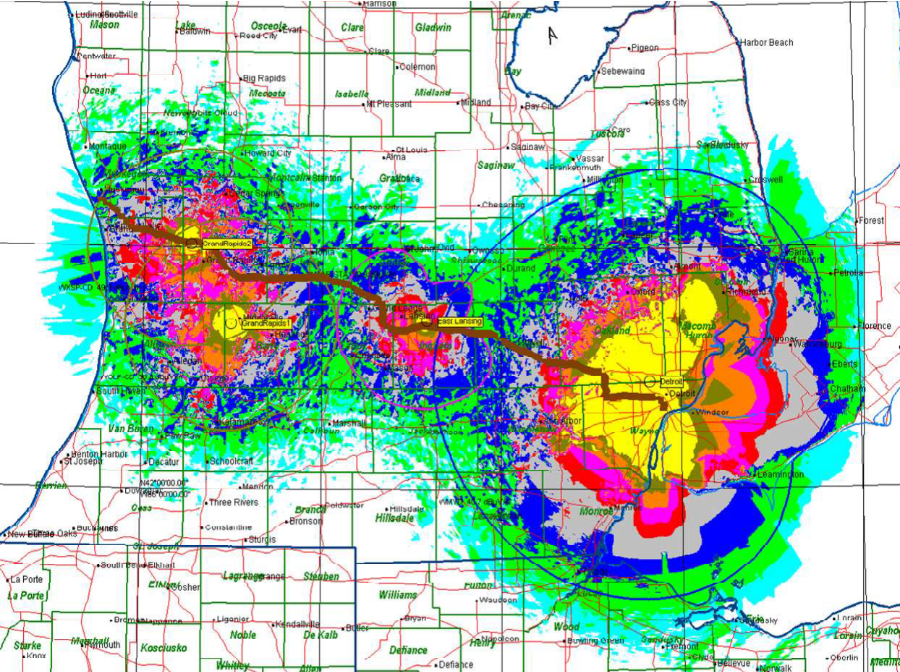NextGen TV: ‘Michigan Coast-To-Coast’ 3.0 Test Proves Viability of IP Data Delivery To Moving Vehicles
WMYD in Detroit, WKAR in Lansing and two Grand Rapids Nexstar stations participated

ATLANTA—Alchemedia SG has demonstrated the successful use of its Broadcast Services Core integrated with other IP services to transport IP data, including media files and an HD video stream, seamlessly to a moving car traveling between four broadcast transmitters, including one each in Detroit and Lansing, Mich., and two in Grand Rapids, the company has announced.
“The Michigan Coast-to-Coast Data Delivery Drive Tests demonstrated that ATSC 3.0 technologies can be implemented now to deliver data over a wide area to moving vehicles reliably and with high throughput,” said ATSC 3.0 consultant Merrill Weiss. “They also showed that there are extensions to the ATSC 3 technologies with the potential to push throughput and reliability to even higher levels. The drive tests used a combination of off-the-shelf broadcast hardware with slightly modified software and prototype mobile receiving equipment that implemented diversity reception.”
Initial testing relied on the data protocols included in 3.0. Later tests showed the improvements possible when more advanced forward error correction software in the market is used, he said.
“All told, the tests showed that, in a matter of months, a quite effective system for reliable data distribution to mobile receivers could be set up using existing infrastructure of multiple television stations to cover an area measured in thousands of square miles,” he said.
Alchemedia SG built the Washington, D.C., -based Broadcast Services Core. Data was carried via a military grade, secure, hybrid public/private network, the company said. Michigan broadcasters participating in the test included The Scripps/Ion-owned WMYD in Detroit, Michigan State University’s WKAR in Lansing and WXSP and WOLP, both Nexstar Media Group stations in Grand Rapids.
DigiCAP and Triveni provided the ATSC 3.0 gateways located at the four stations, while Heartland Video System managed their installation and operation during the tests, the company said.
Forward Error Correction (FEC) became a critical part of the demonstration. An ATSC 3.0-compliant version of KenCast Fazzt FEC was provided via a development and marketing arrangement with Alchemedia SG. The receiver used in the vehicle was a Sony CXD2885 4 node receiver (nicknamed CLOVER), built specifically for in vehicle reception. Tower and fiber infrastructure company Crown Castle assisted with field integration and support for the project.
“While data hand-offs are common in the IT world, delivering data through broadcast spectrum to moving vehicles provides unique challenges,” said Alchemedia SG CEO and co-founder John Heinen.
“The goal of the tests was to prove that reliable data can be received from a variety of transmission systems, across a variety of terrains and with a level of accuracy that can make data for commercial entertainment and vehicle navigation safe and secure. This test demonstrates that ATSC 3.0 broadcast spectrum can offer a variety of video services to consumer and commercial use cases for cars, trucks and commercial vehicle fleets,” he added.
The demonstration proved there is a “pragmatic pathway” toward building a “secure, flexible [and] reliable national datacasting network,” said Lynn Rowe, CTO of Alchemedia SG. “It is time to build,” he said.
Get the TV Tech Newsletter
The professional video industry's #1 source for news, trends and product and tech information. Sign up below.
Phil Kurz is a contributing editor to TV Tech. He has written about TV and video technology for more than 30 years and served as editor of three leading industry magazines. He earned a Bachelor of Journalism and a Master’s Degree in Journalism from the University of Missouri-Columbia School of Journalism.
